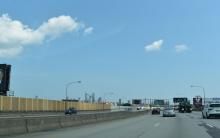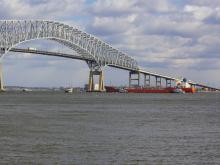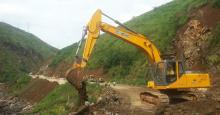A flyover has collapsed in the Indian city of Kolkata. Reports from the local press suggest 14 fatalities and upwards of 150 people being trapped in the wreckage. The Times of India reports that the flyover was under construction at the time of its collapse and the reason for the structural failure has yet to be determined. The flyover is located in a densely populated area in the north of the city and the death toll looks likely to climb.
A flyover has collapsed in the Indian city of Kolkata. Reports from the local press suggest 14 fatalities and upwards of 150 people being trapped in the wreckage. The Times of India reports that the flyover was under construction at the time of its collapse and the reason for the structural failure has yet to be determined. The flyover is located in a densely populated area in the north of the city and the death toll looks likely to climb.
Numerous vehicles have been trapped, many still containing occupants unable to escape. The area under the flyover is also used for commercial purposes according to the Times of India, with many local traders also amongst those trapped. Equipment is being brought in to help free those still trapped in the wreckage but the heavy concrete and steel sections are proving a major challenge.
The Indian Army and the country’s National Disaster Response Force (NDRF) are being brought in to help with the rescue efforts, with local police and fire brigades already providing aid at the scene. The flyover measures around 2km in length and was supposed to have been completed three years ago, but the project has been subject to a number of delays.
The congested nature of the densely populated area and the close proximity of buildings to the site will limit the size of cranes, wheeled loaders or excavators that can be brought in to help with the rescue attempts. Demolition machines with grabs and cutters will be of key importance for the rescues attempts. There have also been criticisms in India already over the disorganised response to this disaster, which is likely to result in additional deaths.
Numerous vehicles have been trapped, many still containing occupants unable to escape. The area under the flyover is also used for commercial purposes according to the Times of India, with many local traders also amongst those trapped. Equipment is being brought in to help free those still trapped in the wreckage but the heavy concrete and steel sections are proving a major challenge.
The Indian Army and the country’s National Disaster Response Force (NDRF) are being brought in to help with the rescue efforts, with local police and fire brigades already providing aid at the scene. The flyover measures around 2km in length and was supposed to have been completed three years ago, but the project has been subject to a number of delays.
The congested nature of the densely populated area and the close proximity of buildings to the site will limit the size of cranes, wheeled loaders or excavators that can be brought in to help with the rescue attempts. Demolition machines with grabs and cutters will be of key importance for the rescues attempts. There have also been criticisms in India already over the disorganised response to this disaster, which is likely to result in additional deaths.









